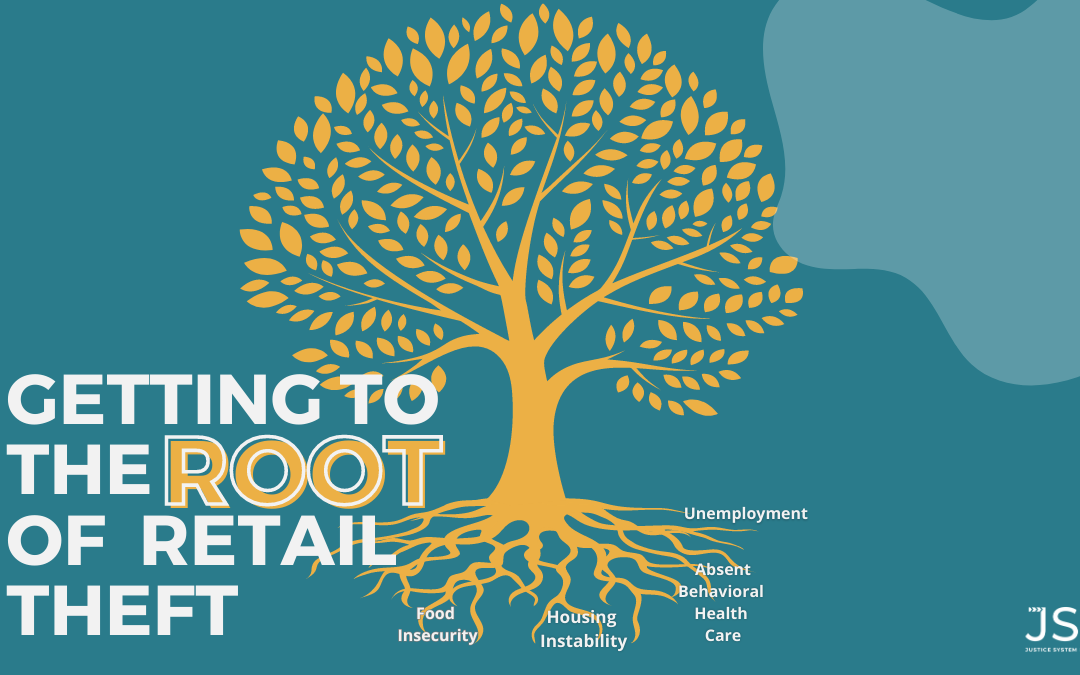Recently, New York City Police Commissioner Keechant Sewell reported that nearly a third of the 6,000 arrests and rearrests for shoplifting in the city last year involved the same 327 people. The Commissioner went on to say victims concentrated among department stores and chain pharmacies. While NY law enforcement believe organized shoplifting groups may be to blame in the Big Apple, across the country residents with limited resources and behavioral health needs are typically responsible. Historically, big-box-retailers and national chain stores prioritize arrest and pressing charges against these individuals.
The Association of Prosecuting Attorneys and Justice System Partners (JSP) are partnering to pilot an alternative solution. Five prosecutor offices have been selected to try a new approach to addressing retail theft by reconsidering prosecution and implementing programs which get to the root of why people steal.
ENDURING CONSEQUENCES OF RETAIL THEFT CHARGES
Typically arrests for retail theft, which includes theft of goods, result in low-level misdemeanor charges. Homelessness, substance use, food insecurity, and generally navigating poverty are all linked to retail theft. The criminal legal system often refers to retail theft charges as “low-level” or minor misdemeanors because they are non-violent crimes, not committed against people, and often for low priced goods.
Unfortunately, there is an enduring belief that there aren’t serious consequences from misdemeanor convictions – that the stakes are small and it’s “not that big of a deal” to have a conviction for these charges. This thinking, common across criminal legal systems, leads to local authorities quickly arresting, charging, and convicting people. For individuals whose circumstances don’t change between arrests, this cycle between petty thefts and misdemeanor convictions, over time, recasts them into “habitual offenders” and then drastically changes how the criminal legal system treats them.
An extensive criminal history, even exclusively for low-level theft, can lead to compounding consequences. When an individual experiences a repeat arrest for a low-level theft:
- The court may require them to pay increasingly more money to secure release from jail. Many of these individuals are too poor to post bail and likely would remain in jail where they could experience job loss or consequences to their health;
- The court might instead assign conditions of release like reporting to the court, electronic or GPS monitoring, or drug testing which research shows can return people to jail, and;
- Prosecutors may be more likely to increase the severity of charges from misdemeanor to felony (depending on state law) and less inclined to dismiss charges or cases, leading to even more convictions where the cycle continues.
Therefore, minor retail theft convictions are not so minor. Eliminating, or even greatly reducing retail theft and the consequences of convictions requires getting to the root of the problem, and connecting people to services which fundamentally change their circumstances.
FUNDAMENTALLY CHANGING PEOPLE’S CIRCUMSTANCES
Justice System Partners will partner with the Association of Prosecuting Attorneys (APA) as the evaluation partner to a reinvention of retail theft diversion programs across five cities.
Guided by the APA, prosecutors’ offices in Columbus, Ohio, 18th Judicial District (Centennial), Colorado, Shelby County, Tennessee, Santa Monica California, and East Baton Rouge, Louisiana will either implement or expand existing retail theft diversion programs. The core goal of these programs is to divert individuals to local community programs where they can get the help they need. Once they complete the local program, prosecutors will dismiss the case – eliminating the devastating consequences of a conviction.
JSP’s INVOLVEMENT AND IMPACT
As the research partner, JSP, led by research associate Dr. Michael Menefee, will collaborate with prosecutors from each of the offices to understand the structure of their programs, help build metrics to understand changes, and then analyze data to understand the impact of these programs on reducing retail theft.
Following the completion of the evaluation at each site, JSP will work with APA to compare findings across the five sites to understand the drivers of reducing retail theft. From these findings, JSP and APA will identify the key components of programs, informing a national model for retail theft diversion.
Dr. Menefee says, “We can’t arrest away this problem. It’s time we think about centering people. Working with each of the retail theft intervention programs presents an opportunity to work with prosecutors across the US to create a new national model. These programs may be an effective alternative to traditional prosecution. If so, when we use them, we then get to the root of retail theft.”
JSP Direct To Your Inbox
Get the latest news and articles from JSP.

